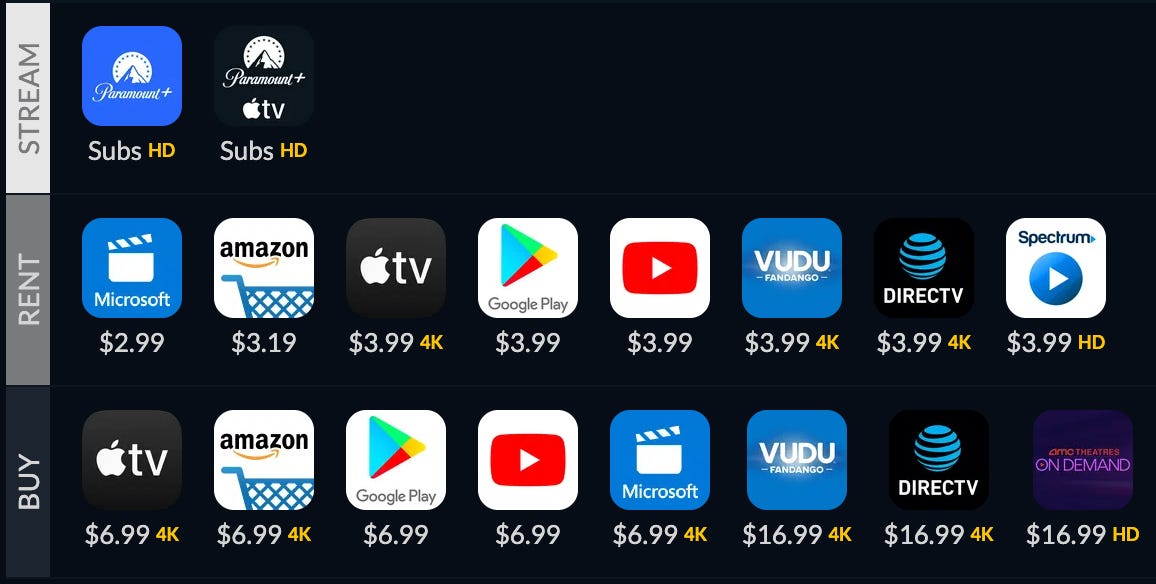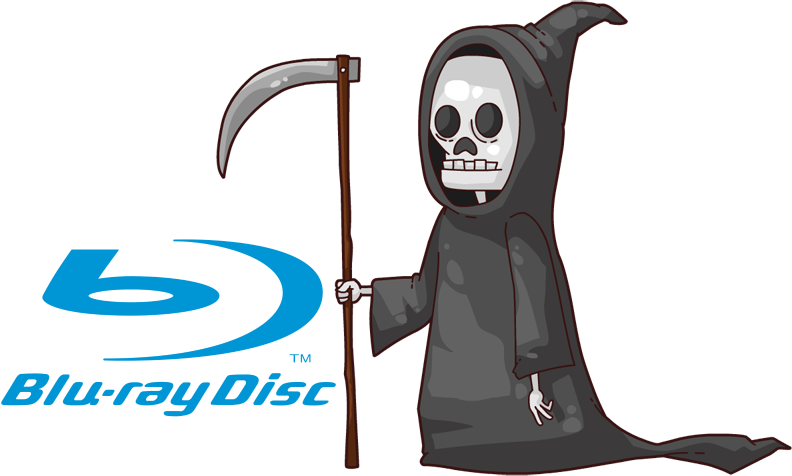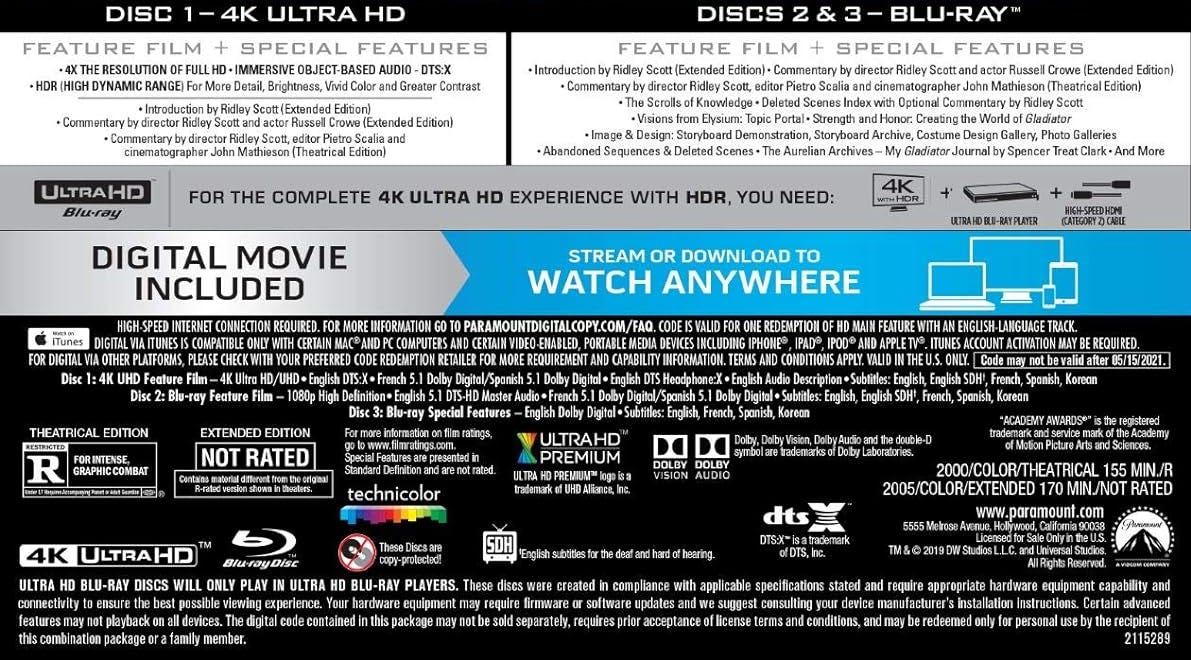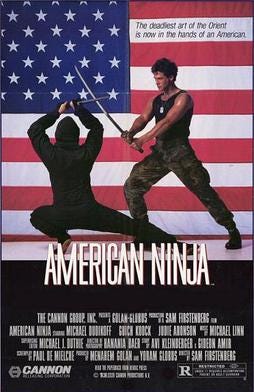Requiem for a Disc
You'll own nothing, and you'll be happy.
Best Buy, which like the mall1, I haven’t been in for over a decade, has finally ditched physical media. News also broke last week that Disney is licensing their production of DVDs, Blu-ray Discs and 4K Ultra HD Blu-rays to Sony. I am a realist, this was inevitable. So while I lament another step towards the end (old man yells at cloud, film at 11)2, there are legitimate reasons why everyone who loves movies should be concerned.

The quality of streaming is sometimes not that amazing, and often dependent on your gear and internet connection. Do you walk into someone else’s home and recoil in horror at the Soap Opera Effect3? If so, you’re probably with me on this. You’re going to get better, deeper blacks on Blu-ray, and there will be less compression versus a stream over the internets. That means less black crush and fewer artifacts like pixelation, macroblocking, banding, blurring, etc. The exception might be a 4k stream with HDR vs a standard Blu-ray without HDR, but that’s not really an apples to apples comparison. A 4K UHD Blu-ray (with HDR) is the gold standard.
The other issue is audio, and a good primer on the different formats available is here. Blu-ray was way out in front on audio, with streamers on mostly lossy formats, but they have been rolling out more and more titles with Atmos (still, compressed). So there’s still a gap, but it is closing.
But none of this really matters. For every one of me, there are likely 100 or 1000 people who either don’t care, or can’t tell the difference. And the ecosystem is not designed for me, it’s designed for everyone else, where convenience is valued over quality, and it’s irrelevant for bingeing a 90s sitcom anyway. A lot of cheap TVs purchased by price sensitive consumers are garbage compared to the high end OLEDs. No one actually calibrates their TV, and a lot don’t even flip over to the best picture preset, usually “filmmaker” or “cinema”. Motion interpolation is left on. The placement of the TV is suboptimal and proper lighting is not considered, leading a lot of people to take a pass on a superior OLED for a brighter, cheaper backlit LCD/LED they saw in the store. TV speakers are not great. A sound bar is better. A receiver and surround-sound system is best. So if you’re the average consumer, you probably won’t notice the banding, or the missing details in a darker scene anyway.
The one time I can think of where this actually mattered was Game of Thrones, season 8, episode 3 - “The Long Night”. You may remember this as that episode where everything went black and you just heard dragon noises for a minute. The uproar on the internet was instantaneous. The compression, along with the congestion of millions trying to stream from Max, was an example of where streaming just couldn’t keep up, and everyone noticed, with the problem exacerbated by the shortcomings of many people’s setups mentioned in the previous paragraph. But that’s one extreme example, not the norm.
Which brings me to the larger problem: Our ability to watch these films in the future may be dependent on streaming rights that regularly come and go, bouncing between services you may or may not have. Websites exist solely to track these moves, and many sites do regular monthly features on this shuffling.

Take Gladiator for example: Gladiator left Netflix at the end of 2023. It resurfaced on Paramount+. 4K? Nope. Special features? Nope. Extended cut? Nope. Any extras whatsoever? Nope.
Meanwhile, the 4K UHD Blu-ray from Amazon is on my front porch tomorrow via Prime for $22, with everything missing from Paramount+ and more. You could at least rent it in 4K, but that feels sort of stupid if you’re already paying for Paramount+. The only place you can digitally purchase the extended cut in 4K is DIRECTV, which I believe requires you to have a DIRECTV subscription. It could be worse though, as many notable films4 have fallen into rights black holes that make streaming impossible.
But even if you could purchase it elsewhere, I wouldn’t advise it. Because you don’t really own it, you license it, and that license can be revoked at any time5. We’ve seen this repeatedly with books, movies, and music, even from big tech companies that still exist. This is not a compelling case against piracy.
So what can we do? Support boutique, indie outfits like Criterion (there is no better provider of physical media) and Kino Lorber - which will probably be all that’s left in another decade. If you’re looking for a replacement for the old school Netflix disc in the mail service, check out Scarecrow. And if you’re lucky enough to have a brick and mortar store in your town, like I do with Videodrome6 in Atlanta, support them, and hope that one day, we see a vinyl-like resurgence of Blu-ray.
My oldest daughter is 13 and I have (so far) dodged the mall trips. I hate shopping and I offer no practical advice on women’s fashion.
One of the first non-kids movies I remember seeing was American Ninja. Sporting a full Blutarsky, 0.0% on Rotten Tomatoes, this cinematic atrocity (and it’s 4 sequels) was a staple of kids growing up in the mid to late 80s, as it was available for rental at Blockbuster, and despite the R rating, contained no nudity, key for parental permission. Ninjas? Check. Gratuitous violence? Check. America? Fuck yeah. If you have any edibles available, you can stream this masterpiece for free on Pluto.
Once this door had been (roundhouse) kicked open, I was able to beg my mom to take me to action movies in the theater, mostly early 90s classics like T2, Speed, True Lies (underrated), Lethal Weapon 3, and Die Hard 2 (1 > 3 > > > 2), where my real love of movies began. I got my first DVD player in late 1999 or early 2000. It was a nice, early Panasonic model that I could not afford, but was able to acquire with an open box discount at Circuit City (I had no idea this place still existed until I made that hyperlink). The Matrix was the first movie I watched on it.
Computer Science at Georgia Tech has a lot of free elective hours, so I got a minor in Film Studies. I fixed computers at Best Buy (pre-Geek Squad) and worked at Movie Gallery to pay bills and feed the addiction with employee discounts. With the Playstation 3 came my first Blu-ray player. I wouldn’t be able to fully appreciate it until a few years later when I could afford a decent plasma TV (RIP), but at this point I stopped caring about seeing films in the theater.
I romanticize all of this in a way that someone who grew up with streaming does not. The THX Deep Note will always give me goosebumps. The difference in the VHS on CRT that I watched as a child to the 4K UHD Blu-ray on OLED of today is genuinely mind blowing. Outside of the theater - this is as close to the director’s vision as it gets. And I fear that when physical media inevitably dies, we will be unable to recreate that vision at home and be left with whatever the streaming services are kind enough to offer us, which may be slightly distorted, missing the nuances in the shadows, if they offer it at all.
It will become my mission to get you to turn off motion interpolation before the evening is over. I am also judging you if have your TV above the fireplace, which is the worst place you can put it.
In recent times, 28 Days Later and Kevin Smith’s Dogma (arguably his best film) are the most glaring examples. Hitchcock’s Rebecca is probably the worst omission, although it occasionally shows up on TCM.
Videodrome just celebrated it’s 25th anniversary. I used to rent Buster Keaton, Charlie Chaplin, and other films like Metropolis for film class over 20 years ago. I’m amazed and thrilled it’s still open.





